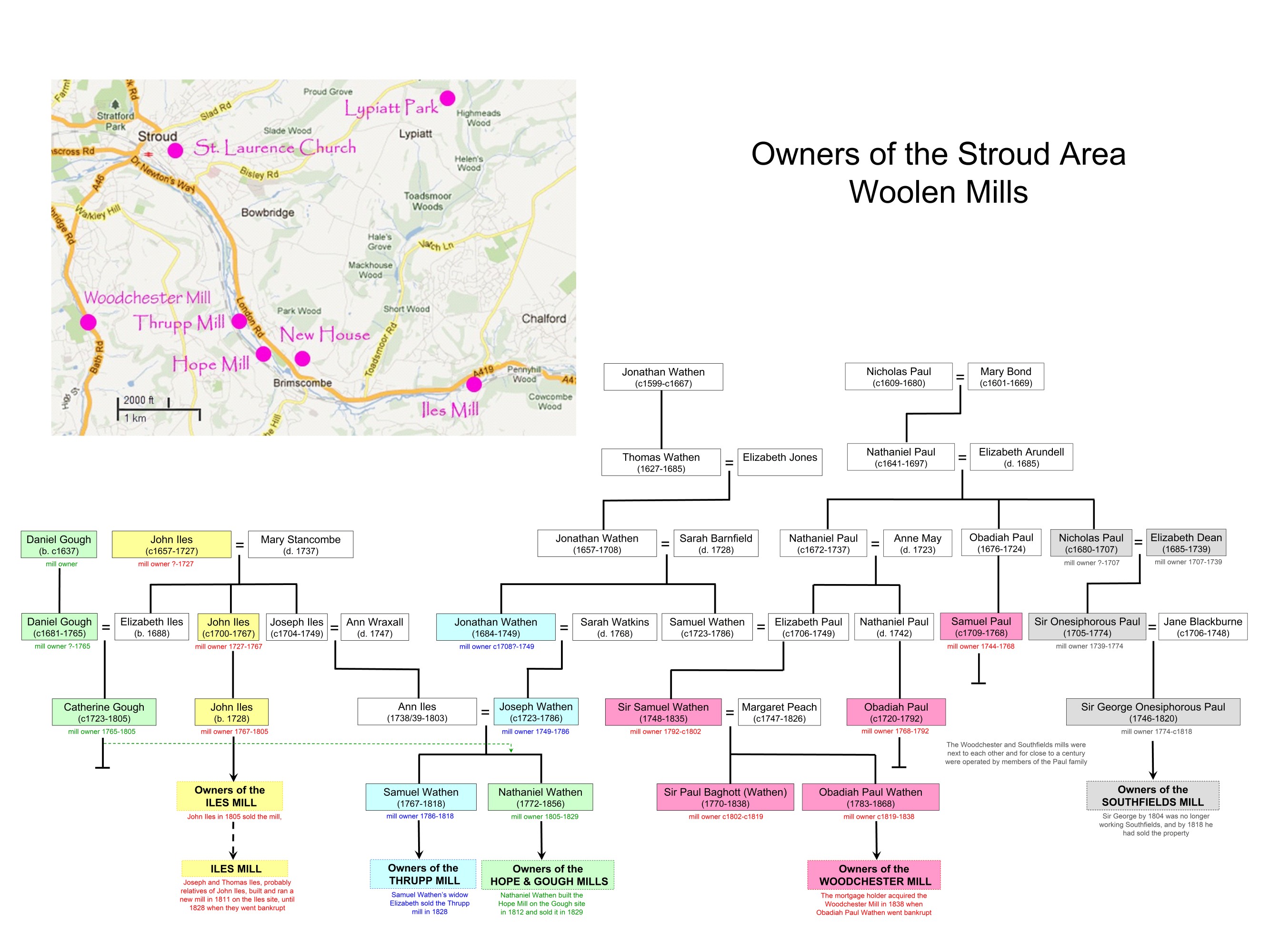 Stroud Woolen Mills Stroud Woolen Mills 
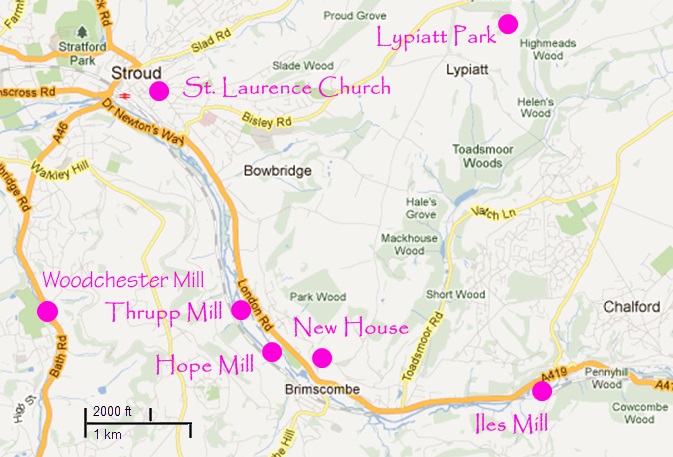
The Thrupp, Hope and Iles mills are three of many mills on the Frome River, which flows west to the Severn River. The Thames-Severn Canal provided a waterway to the Severn, alongside the Frome, which did not interfer with the river flow that before the advent of steam powered the mill waterwheels.
|
Thrupp Mill at Far Thrupp is located on the Frome River, and it was originally called the Huckvale (or Huckfield) Court Mill. It may have existed as early as 1381 when a tucker (i.e., a fuller, which is one who cleans and thickens wool fibers) named John Huckvale (Hokkevale) lived in Nether Lypiatt, and presumably either he or his descendants ran the mill as tenants of the Nether Lypiatt estate. This mill was one of the earliest ones on the river, and the lords of the estate probably built it originally as a grist mill to grind grain, before converting it during the rise of the Gloucesterhire wool industry into a more profitable fulling (tucking) mill.
The Sewell family owned a mill upstream from Huckvale, and Richard Sewell in 1608 occupied the Huckvale Mill as well. Either he or another Richard Sewell still ran the operation in 1635, when the first Richard Sewell died. The property at this time was held freely from Nether Lypiatt, having been either purchased or gifted, and included a messuage (manor house), two fulling-mills for processing raw wool, a gig-mill for processing cloth, and a grist mill for grinding grain. Richard was succeeded by his son Giles, and the mill, which became known as the Sewell Mill, was owned in 1677 by another Richard Sewell, whose widow Ursula in 1705 owned it with her second husband Joseph Gough, a clothier who also owned the nearby Hope Mill. Joseph and Ursula in 1708 sold the mill, which was now known as the Thrupp Mill, to Jeremiah Davis and Richard Baker, who subsequently leased it to another clothier named Jonathan Wathen. When Jonathan died in 1749, his son Joseph Wathen inherited the lease, and Joseph held onto the lease when Dennis Davis inherited the mill in 1752 upon the death of his father Jeremiah.
Joseph Wathen, who had purchased the manor of New House (later Brimscombe Court), had by 1770 acquired enough wealth to buy the Thrupp Mill as well, his family having leased it for several decades from the Davis family. Joseph was not only one of the most successful clothiers in the county, but also one of the promoters of a proposed canal to be dug alongside the Frome River to provide a navigable waterway connecting the Frome mills to the Severn River. The idea was to move mainly coal, but also cloth and clothing, through this canal all year long. Thus, freight could be transported independant of river flow, without interfering with mill operations, the waterwheels of which depended on the river for power. Joseph lived to see the canal open in 1779 with passage from the town of Stroud west to the Severn, and thence to the western coast. However, he died in 1786 before an extension of the Stroudwater was opened in 1789 that connected his mill to the Severn and continued east to connect the Severn to the Thames River, thereby providing an all-year navigable waterway from the east coast of England to the west.
Joseph Wathen was described at the time his death as "one of the most considerable clothiers in the county", and the Thrupp Mill was one of the largest in the county. The mill passed to his widow Anne, whose son Samuel Wathen was now responsible for running the operation, and she subsequently gave it to him in 1792 as a wedding gift on his marriage to Elizabeth Sheppard. Anne died in 1803 and when Samuel died prematurely in 1818, his widow Elizabeth continued to operate the mill until 1828, when she leased it to John Ferrabee.
The Thrupp Mill up to this point had been a woolen mill for most of its existance, but John Ferrabee was an iron-founder, and he made extensive alterations, which included taking down the dwelling-house, and building a foundry. He also removed two of the three waterwheels and their stocks, as steam engines by now provided most of the mill power. The mill under Ferrabee was renamed the Phoenix Ironworks, where John Ferrabee, his sons James and Henry from 1851, and James alone from 1855, produced cloth-making machines, water-wheels, agricultural machinery, and steam engines. The works also made the first lawnmowers, which had been invented in 1830 by a Stroud mechanic Edwin Budding, with the patenting and development financed by Ferrabee. An adjustable spanner invented by Budding was also produced. When John's successor James Ferrabee removed in 1863 to Port Mill, the foundry business at the Phoenix Works was carried on by George Wailes & Co.
Burton, Sons, & Waller, later George Waller & Son, a firm of mechanical engineers, occupied the foundry from 1872, using it to make castings for their main factory in London. The firm in 1887, which by then was part of a larger combine, moved its entire operation to the Phoenix Ironworks. This firm still occupied the works in 1971, when they were chiefly engaged in the production of compressed-air pumps for gas works, sewage works, among other undertakings. The works then employed about 180 people. A water-wheel remained in use until the early 1920s, powering part of a machine-shop. Although re-roofed, the original 1828 foundry building survived in 1971, among more extensive modern buildings. The site is now an industrial complex that is home to several businesses housed in modern buildings.
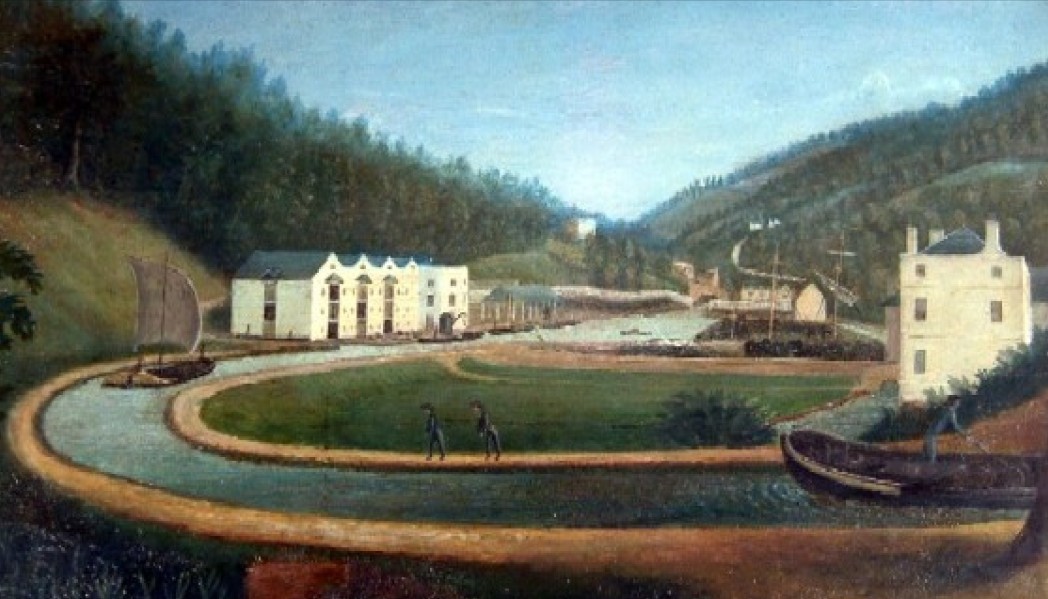
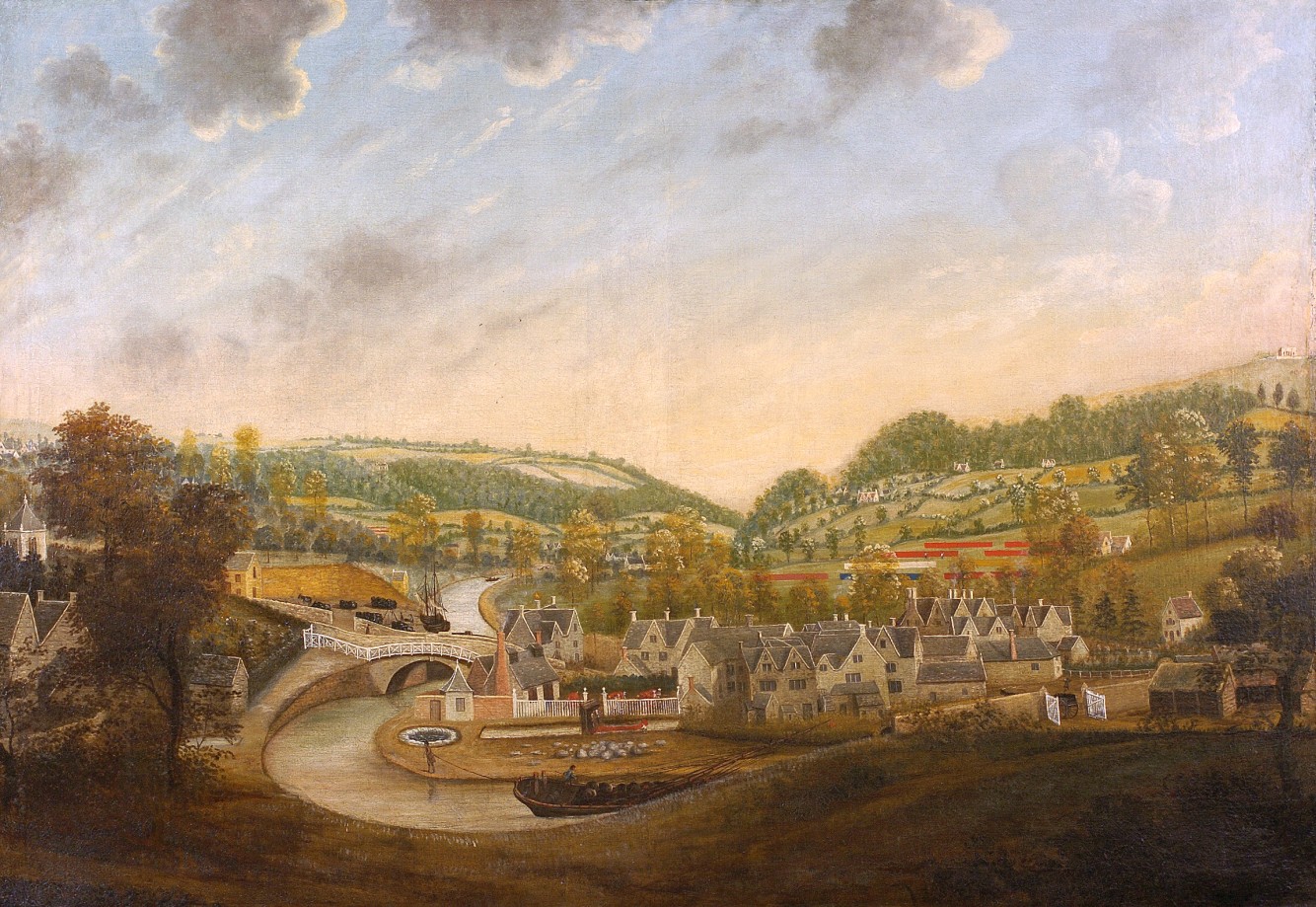
|
|
The painting on left shows the Thames-Severn Canal at Brimscombe Port about 1790 to 1800, when the canal was in full operation. The Hope Mill is located just downstream from here. The painting on the right shows the Wallbridge area of Stroud about the same time, with the Frome River flowing along the south side of town. The artists for both paintings are unknown, and both are part of the collection of the Museum in the Park (Cowle Museum) in Stroud.
|
Hope Mill was built on the Thames-Severn Canal in 1812 a short distance upstream from the Thrupp Mill. However, the canal, which runs along the Frome River, was not completed until 1789, and various mills powered by waterwheels on the Frome have occupied this same site since the early 1500s. Thomas Sewell, a clothier, leased a mill on this site in 1540 from John Whittington of Pauntley Court, when it consisted of a house, fulling mills and a dyeing house. Eventually the Sewell family owned the mill outright, along with a downstream mill at Thrupp, both of which passed in 1705 by marriage from the Sewell family to Joseph Gough, another clothier. Joseph and his wife Ursula, whose first husband Richard Sewell had originally inherited both mills, kept the upstream mill, which now became known as the Gough Mill, and sold the downstream mill, which was now known as the Thrupp mill. The Gough Mill, like the Thrupp, was probably originally built to grind grain, but by now had grown to include three fulling mills and a gig mill for making and processing wool cloth.
When Joseph and Ursula Gough passed on, the mill remained with the the Gough family, and was eventually owned by one Daniel Gough (b. c.1681), who was either a descendant or nephew of Joseph. A deed (#1347) in the Gloucestershire Records Office dated 1748 records that when this Daniel died, he left the Gough Mill to his daughters Catherine (c.1722-1805) and Elizabeth (b. c.1726), both of whom died as spinsters. Nathaniel Wathen and his brother Samuel, the sons of Joseph Wathen of the Thrupp mill, inherited the Gough mill in 1805 on the death of Catherine Gough, who probably was a cousin of their mother Ann Iles. Samuel had earlier received the larger, downstream Thrupp Mill as a wedding present from his mother, and the younger brother Nathaniel was soon working the Gough Mill alone. Nathaniel in 1812 constructed a second mill building on the Gough site, to which he gave the name Hope Mill. He probably outfitted the new mill from the outset with steam engines rather than a waterwheel for power, and, like his father, he enjoyed considerable success and became quite wealthy. He sold both mills in 1829 to Robert Bamford, a woollen yarn manufacturer, who shortly afterwards demolished the older Gough Mill. Nathaniel in the meantime retired to London to become a gentleman of leisure.
Part of the Hope Mill between 1863 and about 1910 was used for silk weaving, and part of it in 1884 was occupied by boat builders Edward Clark & Company, who also made boats at the Central Ironworks in Stroud, both facillities being located on the Thames and Severn Canal. Edward Clark & Company was taken over in turn in 1901 by Abdela & Mitchell, who also made boats and sent them all over the world. Although boat-building continued at the mill until 1937, abandonment of the canal in 1933 meant the finished boats had to be hauled by truck to the Severn River at a significant cost. Industrial sites on both sides of the abandoned canal in 1973 remained in use, and although part of the old stone mill still survived then, its upper storeys had recently been removed. Much of the area has since been cleared of buildings and is now part of Hope Mill Park.
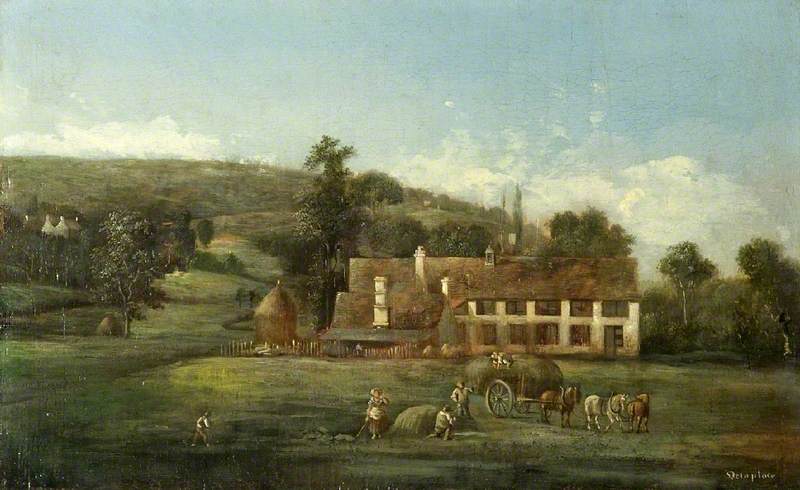
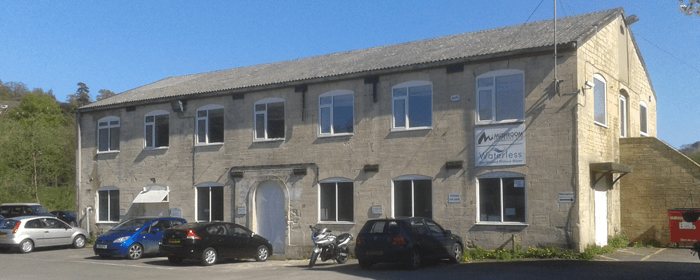
|
|
The painting on the left by Gerardin Delaplace is thought to show the Hope Mill as it looked in the mid-19th century. However, the identity of the mill shown is not certain. This painting today is part of the collection of the Museum in the Park (Cowle Museum) in Stroud. Parts of the mill were torn down over the years, and the photograph on the right shows what remained of the Hope Mill in 2014, when it was being occupied by an internet company.
|
Iles's Mill was located upstream from the Hope Mill, at the village of Chalford, and this mill is probably the same as one that was held by Thomas Butt in 1608, when it was located in between Robert Hone's Mill on the Frome River and the St. Mary's Mill of Henry Whiting. Thomas, who also had four racks on Skaites Hill, just above the river, presumably was a member of the same Butt family that in 1536 owned racks and a dye-house from Bisley manor.
John Iles (d. 1727) took over the mill at some point, either by buying or leasing it, and by 1785 it was owned by the family outright and was being called the Iles Mill. Another John Iles (d. 1767), who was the son of the previous John and related to both the Gough and Wathen families of the downstream Gough and Thrupp mills, had the Iles mill next. Yet another John Iles, no doubt related to the others, sold the mill about 1806 to John Ballinger (d. 1848), who left it to his son Henry (d. 1855).
Thomas Jones was leasing the Iles Mill in 1839 from the Ballinger family, and it is probably the same as a mill that he operated at Chalford six years earlier in 1833 in conjunction with a second mill that he owned at Stroud parish. He is said to have employed some 200 to 300 people, both in the mills and in supporting jobs on the outside. Jones was still making cloth in 1856 at one or both of his mills, but his successors Richard and Joshua Jones set up a factory to make walking sticks at one of the mills, possibly both, in competition with their brother-in-law William Dangerfield. The Jones brothers ultimately went bankrupt in 1865 when they were sued by Dangerfield for infringing on his patented process for putting the bend on the top end of the walking sticks.
William Charles Grist was working the Iles Mill in 1879 as a flock and shoddy factory, and he or his heirs were still there until at least 1902 running the operation - flock being a cloth made by grinding up old used woolens, and shoddy being a cloth made from a mix of recycled wool and new wool. The mill was next occupied in 1906 by a firm of bone turners, who made bone or ivory buttons using a lathe. However, the operations in 1914 returned to a flock mill, this time occupied by Richard Grist, Ltd.
Just below the mill owned by John Iles (d. 1767) is Brookside House, a 17th-century stone building that in the late 1700s was owned by Abraham Walbank (d. 1791), an attorney from the nearby town of Brimpsfield. Walbank was related to Iles as he married Sarah Iles (c.1725-1776) on June 9, 1760 in Minchinhampton, Gloucestershire, Sarah being the niece of John. She was also John's ward, having become so in 1731 upon the death of her father Thomas Iles. Her Uncle John was also one of the witnesses who signed her marriage license when she wed Walbank, basically signing in place of her deceased father. In addtion, land tax records mention the names of John Iles, his brother Thomas Iles, and later Abraham Walbank in association with other properties known as the Berry Farm and Berry estate in Leckhampton, and the Iles Farm in Far Oakridge.
There probably was some sort of a mill in the late 1700s adjacent to Brookside House, but this is not known for certain. Abraham Walbank gave the house in 1782 to his daughter Sarah (1761-1839), who subsequently married a surgeon named Robert Lees (d. 1803) on May 27, 1790 in Minchinampton. When Abraham died in 1791, Sarah acquired the rest of his assets, which apparently included a mill. Sarah then sold the Brookside property in 1811 to clothier Joseph Iles and his partner Thomas Iles - both probably being relatives of the aforementioned brothers John and Thomas Iles of the previous century. Joseph and Thomas then built a new cloth mill and engine house as a wing adjoining Brookside House, but ownership of this wing passed to their creditors in 1828 when their partnership went bankrupt. A series of tenants then occupied this wing until 1882 when it was torn down.
What remains of the mill complex at Chalford is a block that was occupied in 1972 as two separate houses. It includes the aforementioned Brookside House, a three-story British listed stone building (English Heritage Building ID #132873) that dates mainly from the early 19th century, but includes a 17th-century end wall and triangular gable on the north side of the house. The other house, which is on the east end of this block, is also a British listed building (ID #132872). Also, a late 18th-century canal lock and bridge (ID #132871), which dates to the early years of the mill, leads from the highway and over the Thames-Severn Canal to these buildings. Another block of buildings adjoining these houses on the southwest side was demolished in 1913 after a fire.
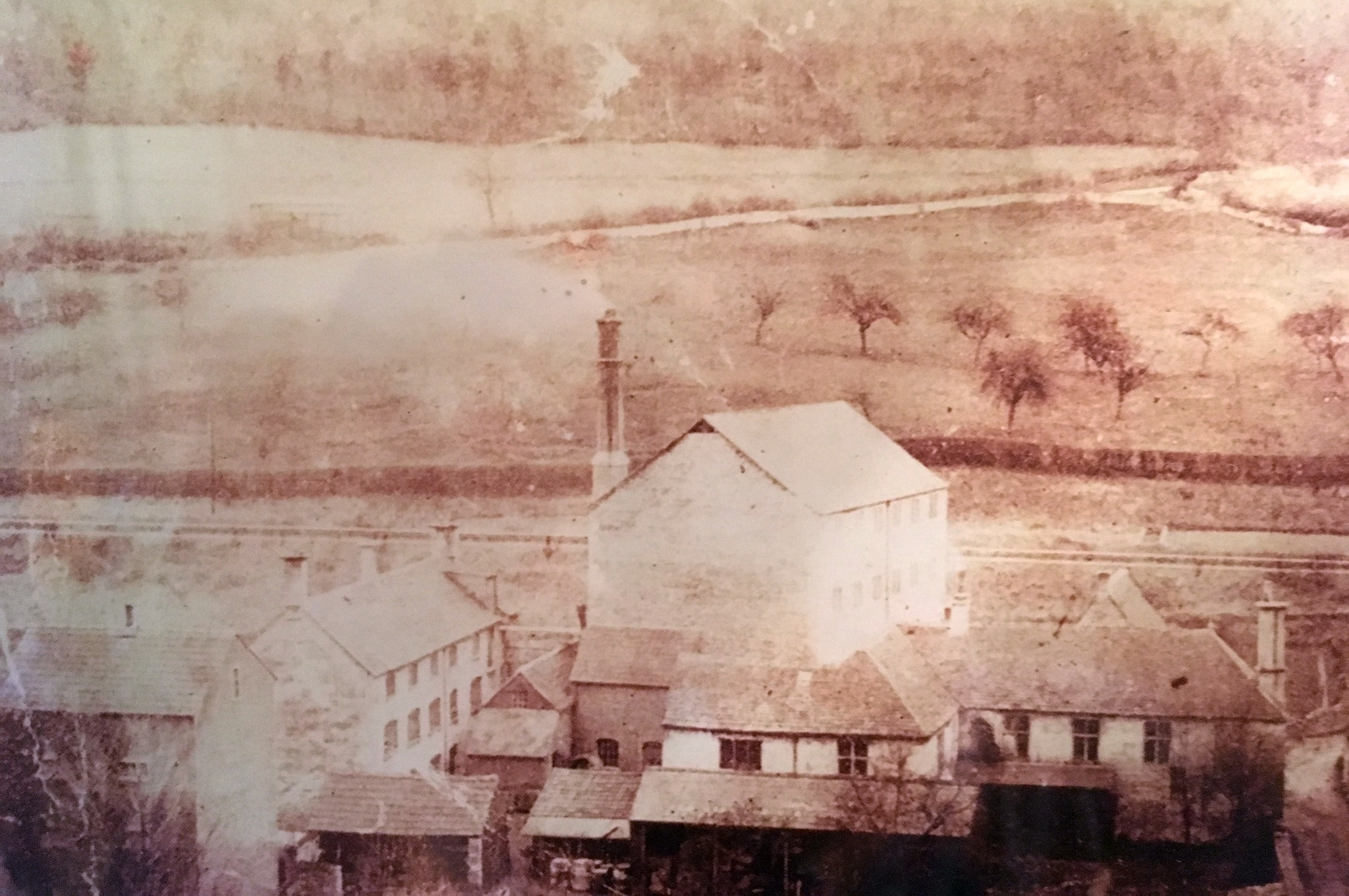
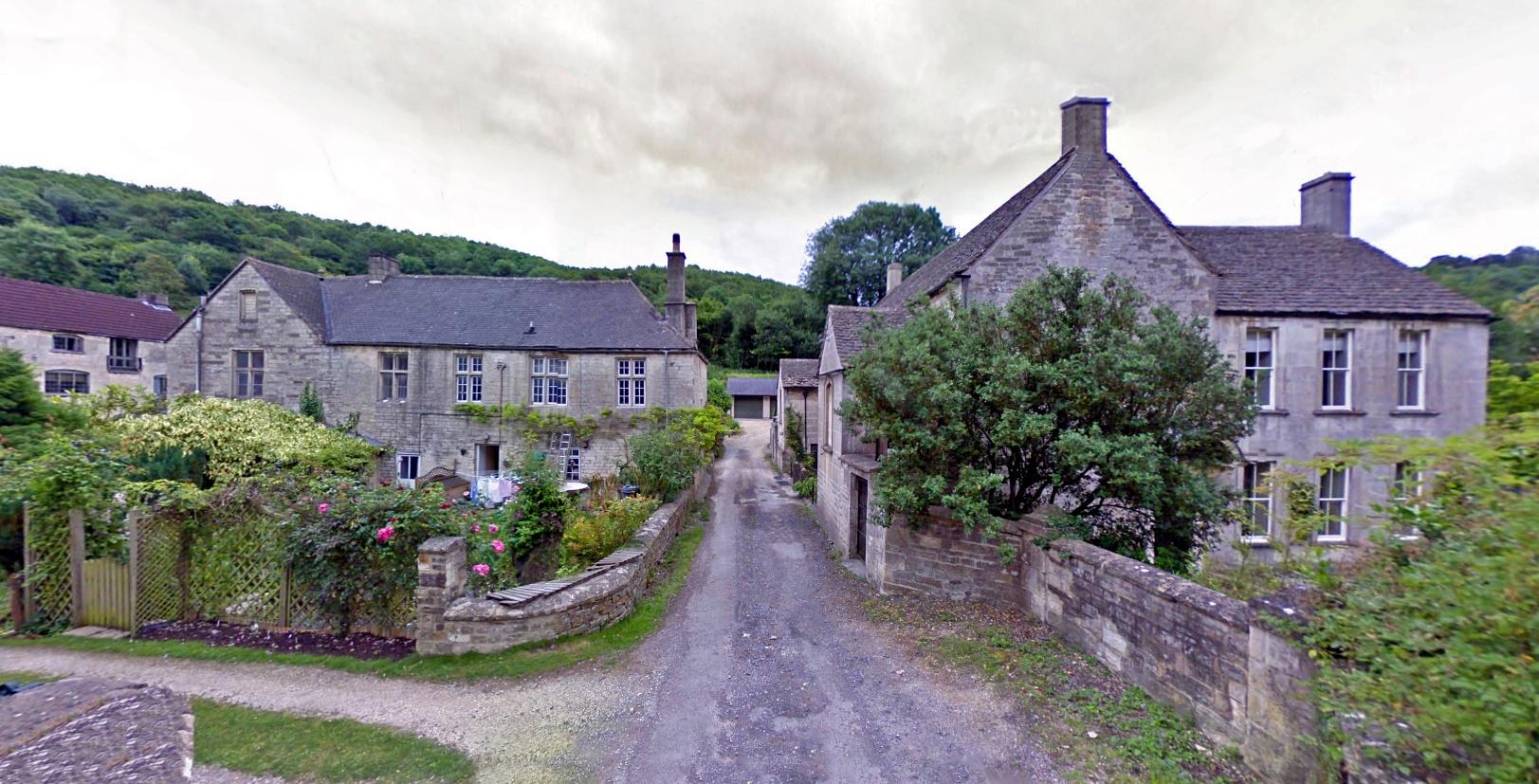
|
|
The photograph on the left (courtesy of Matthew Tom, Brookside) is believed to date from around 1888 and shows the Iles Mill as it then looked. The mill building, now demolished, is the large structure in the center part of the photo, and the building on the left side with two prominent rows of windows, along with the block of buildings in the lower right-hand side of the photograph are all that remain today of the structures shown. The modern photograph on the right shows part of the Iles Mill residential area that occupies the site of the old mill today. The houses on the left are part of the original buildings that surrounded the mill when it was still standing. The house on the right dates in part from around 1690 and was the original house of the mill owner. It became the home of Abraham Walbank of Brimpsfield (d. 1791), who in 1760 married Sarah Iles.
|
Woodchester, Southfields & Rooksmoor Mills were adjacent mills on the Nailsworth Stream at Woodchester, which was one of the parishes in the so-called Stroud District. The Woodchester Mill before 1605 was owned by the Dudbridge family, who in 1744 conveyed a 50-year lease for the mill to Samuel Paul (c.1709-1768) of Rodbrough. Samuel's cousin Onesiphorus Paul (1705-1774) around the same time also acquired the nearby Southfields Mill, which was just upstream from his cousin's mill. Onesiphrous in time acquired a reputation as the most successful clothier in the district, which led to him in 1760 serving as the High Sheriff of Gloucestershire. He was knighted that same year for delivering an address on behalf of the people of Gloucestershire to George III, at the King's coronation ceremony. Two years later the king awarded Sir Onesiphorus the Baronetcy of Rodborough. When Onesiphorus died, the Southfields mill passed to his son, who was named Onesiphorus also, but who added the additional forename of George, to became Sir George Onesiphorus Paul (1745/46-1820). The Woodchester mill stayed in the Paul family also, and when Samuel Paul died it passed to his cousin Obadiah Paul (c.1720-1792), who was a cousin of Sir George.
The Paul family by the late 1700s were the best known of the woolen mill owners in the Stroud district. Their fame grew even more when on Aug. 14, 1788 Sir George, who was the best-known of the family, served breakfast to King George III and Queen Charlotte at Hill House, his manor in Rodborough, and escorted the royal couple afterwards to the Woodchester Mill where his cousin Obadiah Paul gave them a tour of the cloth-making operations there. However, Sir George in time turned his interests more to politics and prison reform than making cloth, so he leased out the Southfields Mill, and sometime before 1818 he sold it. When Obadiah died, the Woodchester mill passed to Sir Samuel Wathen (1748-1835) and his sons, who were close relatives of the Pauls.
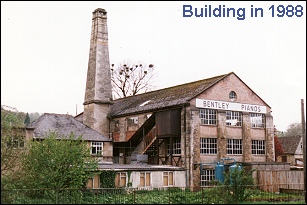 Sir Samuel was quite successful at running the Woodchester Mill, but his sons were less so. His oldest son Paul Wathen, the future Sir Paul Baghott, was operating the Woodchester woolen mill in 1802 when he brought in shearing machines, which led to unrest among his employees. Paul then tore down several mill buildings for some reason, including the main mill, which he subsequently rebuilt. He became known for an extravagant lifestyle, which caught up to him when he was forced to mortgage the mill in 1818 to cover debts. He ended up being forced out of the business by his creditors, which led in 1820 to his younger brothers Joseph and Obadiah Paul Wathen taking over the mill. Sir Samuel was quite successful at running the Woodchester Mill, but his sons were less so. His oldest son Paul Wathen, the future Sir Paul Baghott, was operating the Woodchester woolen mill in 1802 when he brought in shearing machines, which led to unrest among his employees. Paul then tore down several mill buildings for some reason, including the main mill, which he subsequently rebuilt. He became known for an extravagant lifestyle, which caught up to him when he was forced to mortgage the mill in 1818 to cover debts. He ended up being forced out of the business by his creditors, which led in 1820 to his younger brothers Joseph and Obadiah Paul Wathen taking over the mill.
Sir Paul Baghott was declared bankrupt in 1821 for the first time, and subsequently his brothers Joseph and Obadiah in 1823 became joint owners of the property, which by now was heavily mortagaged. Although Joseph Wathen in 1832 was also declared bankrupt, Obadiah continued on with the business. He introduced steam power in 1833 to save labor costs, which no doubt caused more employee unrest. The mill at the time employed perhaps up to 300 people to produce a superfine Saxony broadcloth for the firm of Wathen & Cook, of which Obadiah was senior partner. He remained in production until 1837, when he too went bankrupt, and the mill was taken over by P.H. Fisher, who held the mortgage.
Woodchester continued to operate on and off as a cloth mill over the next several decades, until 1901 when it became a saw mill. Later it housed the Stroud Piano Company. When the main mill building was destroyed in 1938 by fire, it was replaced by a brick mill building that survived until 1989 when it too was destroyed by fire (see photo above and right). The original mill buildings on the site were all demolished long ago, and the late 20th-century structures found here today bear little resemblance to the buildings that formerly stood when the Paul and Wathen families were foremost among the landed gentry of the Stroud area.
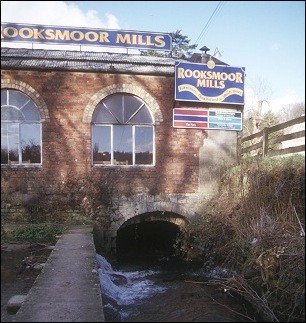 The Rooksmoor Mill was closely associated with the Woodchester Mill, and sat just downstream from it. The first mention of Rooksmoor is in 1729, when it operated as a cloth mill owned by Thomas Small of Nailsworth and later leased out to Edward Peach (c.1710-1770). It was occupied in 1748 by Edward's brother Nathaniel Peach of Rooksmoor (c.1713-1780), who continued to work it until 1773 or later. The mill then in 1805 was owned by Samuel Peach, no doubt a relative of Nathaniel, and occupied by Paul Wathen, who was the great nephew of the aforementioned Nathaniel Peach. Wathen also associated with the nearby Woodchester Mill and later became known as Sir Paul Baghott. His younger brother Charles Wathen was also associated with the mill, as he is referred to in the 1812 death notice of his wife as "Charles Wathen, esq. of Rooksmoor". The mill by 1820 was occupied by Joseph Haigh, who was making cloth there, and he remained until 1829 when his machinery was auctioned off to pay his rent. The Rooksmoor Mill in 2017 was slated to be redeveloped into a modern residential complex. The Rooksmoor Mill was closely associated with the Woodchester Mill, and sat just downstream from it. The first mention of Rooksmoor is in 1729, when it operated as a cloth mill owned by Thomas Small of Nailsworth and later leased out to Edward Peach (c.1710-1770). It was occupied in 1748 by Edward's brother Nathaniel Peach of Rooksmoor (c.1713-1780), who continued to work it until 1773 or later. The mill then in 1805 was owned by Samuel Peach, no doubt a relative of Nathaniel, and occupied by Paul Wathen, who was the great nephew of the aforementioned Nathaniel Peach. Wathen also associated with the nearby Woodchester Mill and later became known as Sir Paul Baghott. His younger brother Charles Wathen was also associated with the mill, as he is referred to in the 1812 death notice of his wife as "Charles Wathen, esq. of Rooksmoor". The mill by 1820 was occupied by Joseph Haigh, who was making cloth there, and he remained until 1829 when his machinery was auctioned off to pay his rent. The Rooksmoor Mill in 2017 was slated to be redeveloped into a modern residential complex.

A possible painting of the Hope Mill and a photograph of the Iles Mill are shown above in the appropriate sections. Unfortunately, we do not have any pictures of the Thrupp, Woodchester or Southfields mills as they once looked. However, below are images of some of the other historic mills on the Frome River in the Stroud, Brimscombe and Chalford areas. The Thrupp, Woodchester and Southfields mills in the early 1800s probably looked similar to these. Included below is a picture of what survives of the Ham Mill, which sits just downstream (north) of the Thrupp mill site.
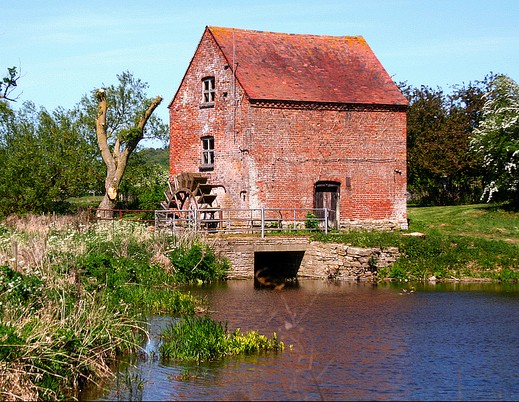
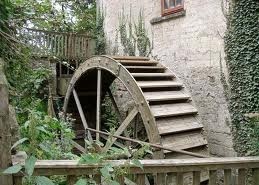
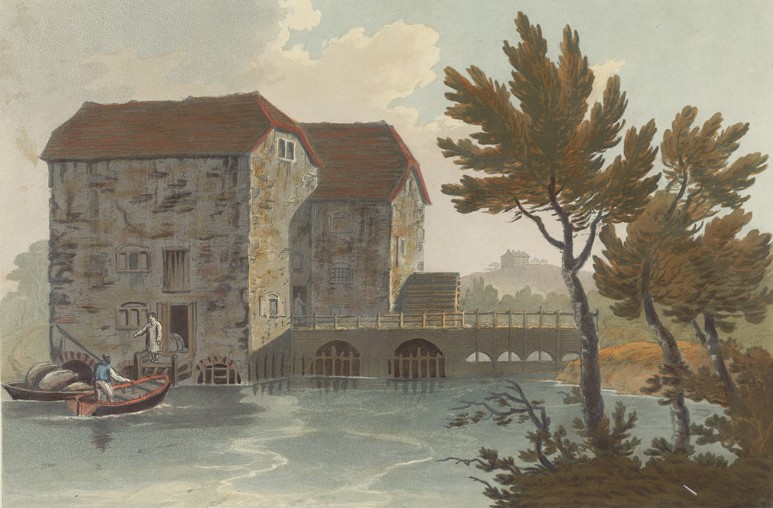
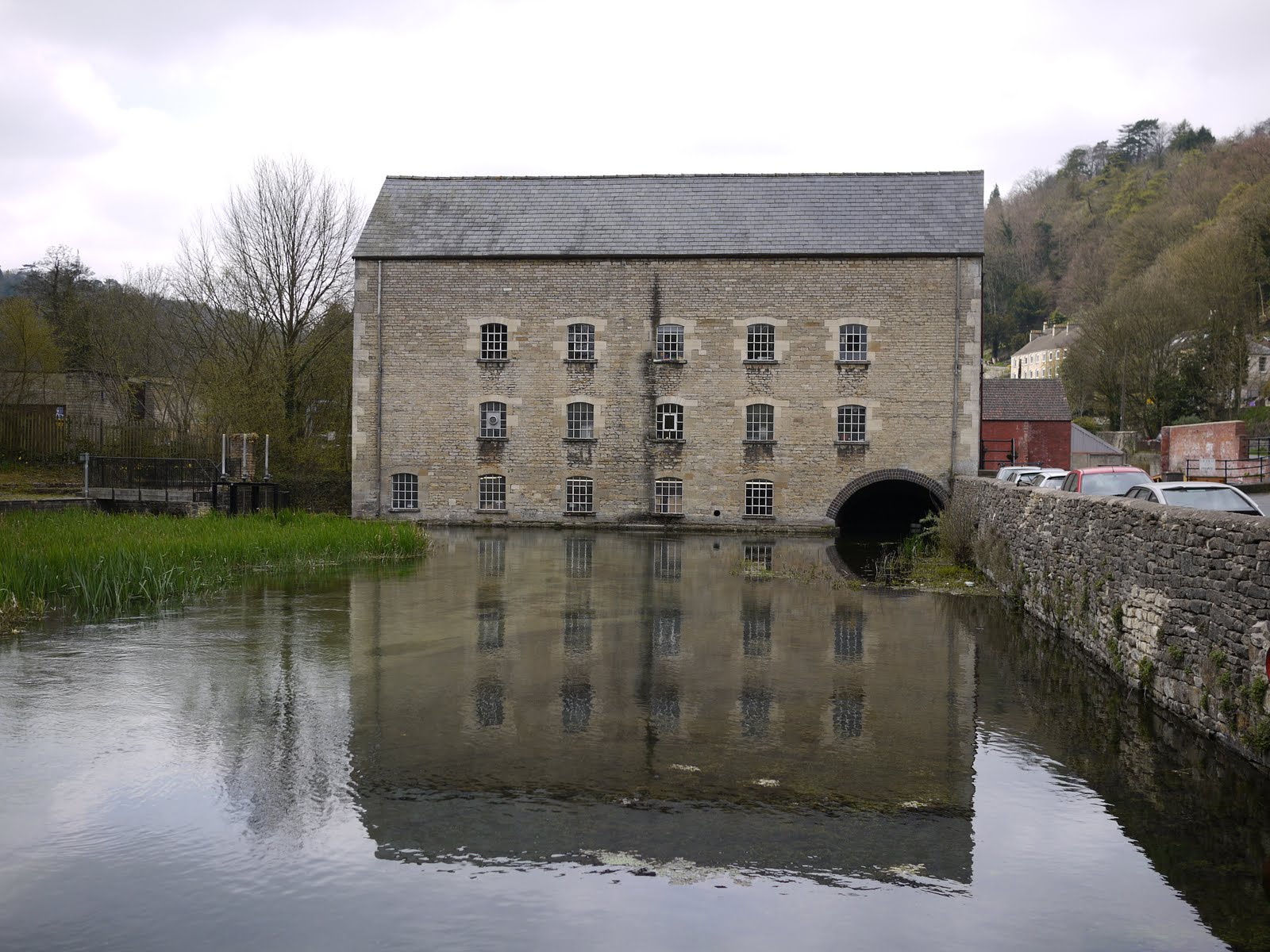
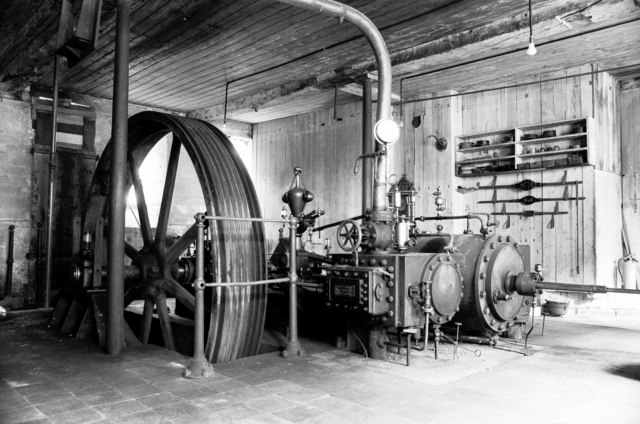
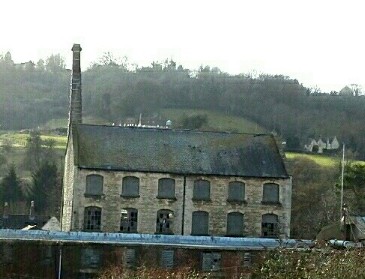
Top Row (L to R): Hartpury (Stroud), waterwheel at Ruskin (Nailsworth), and Tewkwesbury (Stroud) Mill.
Bottom (L to R): Belvedere (Stroud), steam engine at Bath Road (Chalford), and the Ham (Thrupp) Mill.
The descriptions in the previous section are based in large part on A History of the County of Gloucestershire (1976, edited by N.M. Herbert, R.B. Pugh, and others), which is available at British History Online. Another site, which borrows freely from the previous one, is The Cotswold Clothier's Website. And yet another site with informaton on the historic woollen mills of Stroud can be found at Digital Stroud. These references are repeated below.
Thrupp Mill / Huckvale's or Huckfield's Court (Stroud parish)
Thrupp Mill is the early 19th-century name of a mill at Far Thrupp, but before that it usually was called Huckvale's (or Huckfield's) Court. It may have been in existence by 1381 when John Huckvale (Hokkevale), a tucker, was living in Nether Lypiatt. Richard Sewell occupied the mill in 1608, and he or another Richard owned Huckvale's Court at his death in 1635 when it comprised a messuage, two fulling-mills, a gig-mill, and a gristmill, held freely from Nether Lypiatt manor. Richard was succeeded by his son Giles, and in 1677 the property belonged to another Richard Sewell, whose widow Ursula and her second husband Joseph Gough, clothier, owned it in 1705. In 1708 Joseph and Ursula and the heirs of her first husband conveyed the mill to Jeremiah Davis and Richard Baker, and by 1752, called Sewell's Mill, it had passed to Jeremiah's son Dennis who was leasing it to Jonathan Wathen, clothier. By 1770 it had passed to Joseph Wathen of New House, who was described at his death in 1786 as one of the most considerable clothiers in the county. Joseph's widow Anne owned the property in 1792 and settled it on the marriage of her son Samuel Wathen. Anne died in 1803 and Samuel in 1818.
Elizabeth Wathen, Samuel's widow, leased Thrupp Mill in 1828 to John Ferrabee, iron-founder, who was empowered to make extensive alterations which included taking down the dwelling-house, removing two of the three water-wheels and their stocks, and building a foundry. The mill thus became the Phoenix ironworks where John Ferrabee, from 1851 his sons James and Henry, and from 1855 James alone, carried on the production of cloth-making machines, water-wheels, agricultural machinery, and steam-engines. The works also made the first lawn-mowers: that machine was invented in 1830 by a local mechanic Edwin Budding and its patenting and development financed by John Ferrabee. An adjustable spanner invented by Budding was also produced. After James Ferrabee's removal to Port Mill in 1863 the foundry business at the Phoenix works was carried on by George Wailes & Co. From 1872 Burton, Sons, & Waller, later George Waller & Son, a firm of mechanical engineers, occupied the foundry using it to make castings for their main factory in London, and in 1887 the firm moved the whole of its plant to the Phoenix works. Waller & Son, by then part of a larger combine, still occupied the works in 1971 when they were chiefly engaged in the production of compressed-air pumps for gas-works, sewage-works, and other undertakings; the works then employed about 180 people. A water-wheel remained in use until the early 1920s, powering part of a machine-shop, and in 1971 the original foundry building of 1828 survived, although reroofed, among more extensive modern buildings.
(
From: "Stroud: Economic history", A History of the County of Gloucester: Volume 11: Bisley and Longtree Hundreds (1976), pp. 119-132. Available at British History Online. Accessed 30 September 2013.)
Gough Mill / Hope Mill (Rodborough parish)
In 1540, Thomas Sewell, clothier, leased the mill here from John Whittington of Pauntley Court. It consisted of a house, fulling mills and a dyeing house. By 1705, the mill had passed by marriage from the Sewells to Joseph Gough, clothier. It became known as Gough Mills. It then consisted of three fulling mills and a gig mill. (From Hope Mill at Digital Stroud.)
Hope Mill, below Brimscombe, known as Gough's Mill in the 18th century, was the highest on the Frome in Rodborough parish. Daniel Gough, clothier, left it to his daughters Elizabeth and Catherine, and John Cambridge was making cloth there as tenant of the Goughs in 1768. Catherine, the survivor of the two sisters, died c. 1805, leaving the mill to Samuel Wathen of New House, Stroud, and Nathaniel Wathen, who were in partnership as clothiers, presumably working Hope Mill, in 1807. Later Nathaniel made cloth there alone, building a new mill at the site c. 1812. He sold Hope Mill in 1829 to Robert Bamford, who turned it to woollen-yarn spinning and still owned and occupied it in 1839. By 1863 it was being used as a silk-mill by Charles Barton, whose firm remained at the mill until c. 1910. From 1878 part of the Hope Mill site was used as an engineering works by Edwin Clark who later began to build steam launches. After his death c. 1897 the business, for which large new buildings were put up on the opposite bank of the canal, was acquired by I. J. Abdela of Manchester, who greatly expanded it. The abandonment of the canal in 1933 made launchbuilding difficult but the business survived until the late 1930s. In the 1930s the old mill building was occupied by Dorax Ltd., makers of brake linings. The sites on both sides of the canal remained in industrial use in 1973, and part of the old stone mill survived, its top storeys having been recently removed.
(
From: "Rodborough: Economic history", A History of the County of Gloucester: Volume 11: Bisley and Longtree Hundreds (1976), pp. 224-230. Available at British History Online. Accessed 18 October 2017.)
Iles Mill (Bisley parish)
Iles's Mill was probably the one held by Thomas Butt in 1608, lying between Robert Hone's mill and Henry Whiting's St. Mary's Mill. Thomas, who also had four racks on Skaites hill just above, presumably came from the family which held racks and a dye-house from Bisley manor in 1536. The mill, which apparently belonged to John Iles (d. 1727) and John Iles (d. 1767), was described as Mr. Iles's Mill in 1785. About 1806 another John Iles sold it to John Ballinger (d. 1848) who left it to a younger son Henry (d. 1855). The tenant in 1839 was Thomas Jones and Iles's Mill was perhaps that at Chalford which he was operating in conjunction with a mill in Stroud parish in 1833 when he was employing between 200 and 300 people, including outdoor workers. He was still making cloth at Iles's Mill in 1856. Later Richard and Joshua Jones, brothers-in-law of William Dangerfield, set up a rival stick factory at the mill, but they went bankrupt in 1865 and were then being sued by Dangerfield for infringing his patent for the process of bending the sticks. In 1879 and until at least 1902 William Charles Grist worked the mill as a flock and shoddy factory. In 1906 it was occupied by a firm of bone turners, but in 1914 it was once more a flock-mill, occupied by Richard Grist Ltd. The surviving part of the mill was occupied as a pair of houses in 1972; a small three-storey stone building, it dates mainly from the early 19th century but incorporates a 17th-century gable end. Another block adjoining it on the southwest side was demolished after a fire in 1913. The building immediately west of Iles's Mill, occupied as cottages in 1972, belonged to the mill estate in the early 19th century and appears to have been a single house of traditional plan, perhaps dating from the early 17th century.
Another mill was built in the early 19th century just below Iles's Mill, adjoining the house which was known as Brookside in 1972. The house belonged to Abraham Walbank, an attorney, who conveyed it in 1782 to his daughter Sarah, who married Robert Lees, a surgeon. In 1811 Sarah sold it to Joseph Iles, clothier, who went into partnership with Thomas Iles and built a cloth-mill and enginehouse on the site. Joseph and Thomas went bankrupt in 1828 and the house and mill were assigned to their chief creditors, Joseph Pitt and his partners, bankers of Cirencester, who were leasing the mill to Handy and Jesse Davis in 1836. In 1840 Pitt and his partners sold the property to Samuel Lawrence of Cirencester. A long wing which ran south from Brookside and evidently housed the mill, had been demolished by 1882. The surviving house has a symmetrical late-17th century range which was enlarged in the 18th century by the addition of small balancing wings to the east front and a larger range to the west front.
(
From: "Bisley: Economic history", A History of the County of Gloucester: Volume 11: Bisley and Longtree Hundreds (1976), pp. 20-30. Available at British History Online. Accessed 18 October 2017.)
Woodchester, Southfields & Rooksmoor Mills (Woodchester parish)
Southfields Mill, in Woodchester, was owned by Elizabeth (Dean), widow of Nicholas Paul, c.1718 when she retained it for her own use. Elizabeth's son Onesiphorous, later Sir Onesiphorous Paul, Baronette, was working the mill in 1731, and he received Frederick, Prince of Wales, there in 1750. Sir Onesiphorous died in 1774 and was succeeded by his son Onesiphorous, who assumed the additional forename George in 1780 to become Sir Onesiphorous George, at which time he was apparently still working the mill. Sir George, active in county politics and prison reform, had ceased to work the mill by 1804 when it was occupied by William and Richard Cooper. By 1818 it was owned by William Peach Cooper and worked by Thomas Sykes. From 1838 and for the remainder of the 19th century, it was worked in conjunction with Churches' Mill and New Mill and contained two dye-houses, a teazle-house, a tentering house, and a gig-shop when it was put up for sale in 1900. It was occupied by Southfields Stick Mills Ltd. in the 1920s. The main buildings had been demolished by 1972 but some small 19th-century buildings were then occupied by Arthurs Press Ltd. which employed 130 people on the site.
(
From: "Woodchester: Economic history", A History of the County of Gloucester: Volume 11: Bisley and Longtree Hundreds (1976), pp. 298-301. Available at British History Online. Accessed 18 October 2017.)
Woodchester Mill, downstream of Southfields Mill, was sold by Henry Dudbridge to Sir George Huntley in 1605. The following year Sir George leased the mill to Henry for 99 years and at the same time conveyed the freehold to Stephen Dudbridge, Henry's son. The mill, comprising two fullingmills and a grain-mill under one roof, passed from Stephen (d. 1639) to his second wife Elizabeth and then to his son Stephen. From the younger Stephen it passed to his son Henry (d. 1727), and Holliday Dudbridge owned the mill c. 1731 when, having erected a new mill by the older building, he was in dispute with Onesiphorous Paul of Southfields Mill over the water supply. In 1744 the property was leased for 50 years to Samuel Paul of Rodborough who evidently still occupied it at his death in 1768, when he was said to be the greatest clothier in the county. Ownership of the mill passed from Holliday Dudbridge (d. 1752) to William Webb, the husband of his niece Anna, and William conveyed the premises in 1771 to Obadiah Paul, who held the lease by devise from Samuel. Obadiah received George III and the royal family at the mill in 1788. After his death in 1792 it passed to his nephew Samuel Wathen, later Sir Samuel, and it was being worked by Samuel's son Paul Wathen in 1802 when the introduction of shearing machines led to unrest among the employees. The old mill building was demolished soon after and new buildings erected. Paul Wathen, who had changed his name to Baghott, continued to work the mill in 1818, by which time it was mortgaged, but by 1820 it was being worked by Joseph and Obadiah Paul Wathen, two other sons of Sir Samuel, who became joint owners in 1823. By 1833 steam-power had been introduced to the mill which was employing between 200 and 300 people in the production of superfine Saxony broadcloth for the firm of Wathen & Cook, in which O. P. Wathen was senior partner. Wathen was declared bankrupt in 1837 and the mill passed into the possession of P. H. Fisher, the mortgagee.
Woodchester Mill was unused in 1838 but by 1845 it was being worked as a cloth-mill by John and Edward Wise, and Edward Wise bought it from P. H. Fisher in 1868 and continued there until at least 1879. In 1885 the mill was occupied by the cloth-making firm of Ellis & Apperly but clothproduction ceased soon after and in 1901 the buildings were used as a saw-mill. By 1911 a firm of piano-makers, called Gladman & Co. and later the Stroud Piano Co., occupied the mill, but in 1938 the main building, on the north side of Selsley Road, was burnt down and the firm converted the buildings on the south side of the road. During the Second World War the factory was used by the Gloster Aircraft Co. but production of pianos was resumed after the war. The firm, known as the Bentley Piano Co., continued at the site in 1972 when some large industrial buildings of the early 19th century remained south of Selsley Road and a small cottage of the same date survived near the older mill-site, on which office accommodation was built in the 1950s. The company also occupied a 20th-century factory east of Southfields Mill from 1938 and in 1972 employed 120 people on both sites. On the opposite side of the road to Woodchester Mill stands Grigshot House, which was the residence of the owners of the mill in the late 18th and early 19th centuries; it is a tall, gabled building of the late 18th century.
(
From: "Woodchester: Economic history", A History of the County of Gloucester: Volume 11: Bisley and Longtree Hundreds (1976), pp. 298-301. Available at British History Online. Accessed 18 October 2017.)
Rooksmoor Mill, the highest on the Nailsworth stream in Rodborough parish, has not been found recorded before 1729 when it was a cloth-mill owned by Thomas Small of Nailsworth who leased it to Edward Peach, clothier. In 1748 it was occupied by Nathaniel Peach, who continued to work it until 1773 or later. In 1805 the mill was owned by Samuel Peach and occupied by Paul Wathen, and Joseph Haigh was making cloth there in 1820 and until 1829 when his machinery was auctioned under distress for rent. In 1839 Charles Peach had the mill in hand. By 1863 it was occupied by John Grist, flock and shoddy manufacturer, whose firm remained there until 1935 when the business changed hands and was continued as the Stroud Flock Co. until 1963. The company's efforts were then redirected mainly to a new firm, Rooksmoor Mills Ltd., supplying furniture and carpeting by mail order, and in 1973 c. 20 people were employed in that venture and in the manufacture of soft filling for toys
(
From: "Rodborough: Economic history", A History of the County of Gloucester: Volume 11: Bisley and Longtree Hundreds (1976), pp. 224-230. Available at British History Online. Accessed 18 October 2017.)
|
|
 Stroud Woolen Mills
Stroud Woolen Mills 
















